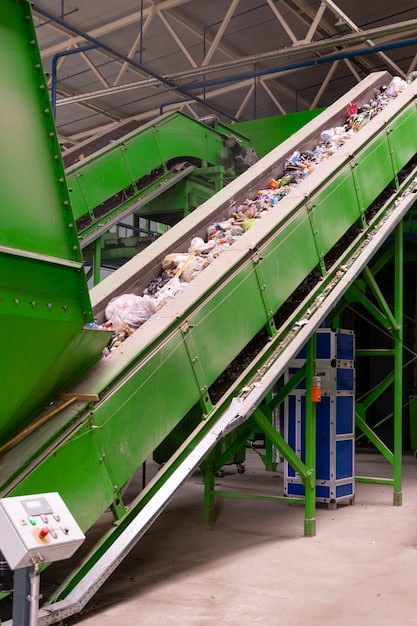Implement a Community Recycling Program: Boost Participation by 15%

Implementing a community recycling program involves assessing needs, securing funding, educating residents, and providing convenient recycling solutions to increase participation by 15% through strategic planning and community engagement.
Want to make a real difference in your community? Learning how to implement a community recycling program and increase participation by 15% can transform waste management and foster a more sustainable environment. Let’s explore the practical steps you can take to drive meaningful change.
Getting Started: Assessing Community Needs
Before launching any recycling initiative, understanding your community’s existing habits and needs is crucial. This initial assessment will shape the program’s design and ensure it effectively addresses local challenges.
Conducting Surveys and Interviews
Gathering data through surveys and interviews offers valuable insights into current recycling practices and attitudes. What materials are currently being recycled, and what are the barriers to increased participation?
- Analyze current waste disposal methods used by residents.
- Identify common reasons for not recycling, such as lack of awareness or inconvenient access.
- Gauge interest in new recycling programs and specific incentives that might boost involvement.
Analyzing Waste Composition
A waste composition study provides a clear picture of what ends up in the trash. This information helps you tailor the recycling program to target the most prevalent recyclable materials in your community.

By understanding the composition of waste, local authorities can implement recycling programs more efficiently and effectively. Waste composition analysis helps to determine the range of materials produced by residents that could potentially be recycled.
Assessing community needs lays the groundwork for a successful and sustainable recycling program. This initial research helps tailor the program to meet the specific challenges and opportunities within your community.
Securing Funding and Resources
Implementing a successful recycling program requires financial support and access to necessary resources. Exploring various funding avenues and resource options is essential for long-term viability.
Applying for Grants and Sponsorships
Numerous organizations and government agencies offer grants specifically for environmental initiatives. Researching and applying for these grants can provide significant financial backing.
- Explore federal, state, and local government grant programs.
- Seek funding from private foundations dedicated to environmental conservation.
- Approach local businesses for sponsorships in exchange for promotional opportunities.
Partnerships with Local Businesses
Collaborating with local businesses can provide not only financial support but also valuable resources and expertise. Forming partnerships can enhance the program’s reach and impact.
Partnerships with local businesses can involve financial sponsorship, resource sharing, or even joint marketing efforts. For instance, a local grocery store might offer collection points for recyclable materials, with the partnership then advertised via joint marketing initiatives on social media.

Securing adequate funding and resources is crucial for creating a sustainable and impactful community recycling program. By exploring diverse funding avenues and fostering strategic partnerships, the program can thrive and achieve its goals.
Educating and Engaging the Community
Education is paramount in fostering a culture of recycling. A well-informed community is more likely to actively participate and support recycling initiatives. Therefore, creating a comprehensive education and engagement strategy is essential. Informing residents about why it is essential to recycle.
Developing Educational Materials
Creating informative and engaging materials is key to raising awareness and changing behavior. These materials should be readily accessible and tailored to different segments of the community.
- Design attractive and easy-to-understand brochures and flyers detailing what can be recycled.
- Create engaging social media content to promote recycling tips and program updates.
- Develop presentations for schools, community groups, and local events.
Organizing Events and Workshops
Interactive events and workshops provide opportunities for hands-on learning and community building. These activities can transform recycling from a chore into a shared community goal.
Organizing interactive events and workshops serves as a vital method for fostering a hands-on learning environment and cultivating a solid sense of community. These gatherings have the capacity to reshape how residents see recycling, turning what may have felt like a chore into a collaborative and unified community objective, and improve how to recycle.
Educating and engaging the community forms the backbone of a successful recycling program. By developing comprehensive educational materials and organizing interactive events, the program can foster a culture of recycling and drive meaningful change.
Setting Up Convenient Recycling Options
Accessibility plays a significant role in participation rates. By providing convenient recycling options, you make it easier for community members to integrate recycling into their daily routines.
Implementing Curbside Collection
Curbside collection is one of the most effective ways to boost recycling rates. Providing residents with designated bins and scheduled pickup services simplifies the recycling process.
Implementing curbside collection can have implications on public spending and resource allocation, but at the same time may result in increased participation. It’s a practical way to make recycling easier.
Establishing Drop-Off Centers
Drop-off centers offer an alternative for residents who may not have access to curbside collection. Strategically located and well-maintained, these centers provide a convenient recycling point.
Setting up conveniently located drop-off centers for recyclables provides residents with an accessible place to discard materials. Strategic placement is key to maximizing convenience and attracting a steady flow of recyclables.
Creating convenient recycling options is essential for maximizing community participation. By implementing curbside collection and establishing accessible drop-off centers, the program can empower residents to recycle effortlessly.
Promoting and Incentivizing Participation
Incentives and promotions can serve as powerful motivators, encouraging greater participation in recycling programs. A compelling incentive structure can transform recycling from an optional activity into a rewarding habit.
Offering Rewards and Recognition
Rewarding residents for their recycling efforts can significantly boost participation. Recognition programs and tangible rewards can create a positive association with recycling.
- Implement a points-based system where residents earn points for recycling, redeemable for local discounts.
- Host monthly contests with prizes for the most improved recycling households.
- Publicly recognize top recyclers in community newsletters and on social media.
Launching Awareness Campaigns
Sustained awareness campaigns help keep recycling top of mind. By consistently communicating the benefits of recycling, you can reinforce positive behaviors and attract new participants.
Launching consistent awareness campaigns is crucial for maintaining a constant reminder of the importance of recycling within the community. Through strategic communication efforts, positive behaviors linked to recycling can be reinforced, while simultaneously attracting new individuals to take part in sustainable practices.
Promoting and incentivizing participation is essential for maximizing the impact of the recycling program. By offering rewards and launching sustained awareness campaigns, the program can sustain high participation levels.
Measuring Success and Continuous Improvement
Tracking program performance and making data-driven adjustments is crucial for long-term success. Regular monitoring and evaluation ensure the program remains effective and adapts to changing community needs.
Tracking Recycling Rates
Monitoring recycling rates provides a clear indication of program effectiveness. By tracking the amount of materials recycled over time, you can identify areas for improvement and measure the impact of initiatives.
- Establish a system for collecting and analyzing recycling data.
- Compare recycling rates before and after program implementation.
- Set benchmarks for improvement and track progress towards goals.
Collecting Feedback and Making Adjustments
Community feedback provides valuable insights into program strengths and weaknesses. Actively seeking and responding to feedback ensures the program meets community needs and remains relevant.
By actively seeking and responding to community feedback, recycling programs can adapt to meet residents’ evolving needs, improving overall participation and satisfaction.
Measuring success and continuously improving the program is vital for long-term sustainability. By monitoring recycling rates and collecting community feedback, you can ensure the program remains effective and responsive to community needs.
| Key Point | Brief Description |
|---|---|
| 📊 Assess Needs | Understand community waste & recycling habits via surveys and analysis. |
| 💰 Secure Funding | Explore grants & partnerships with local businesses for resources. |
| 📣 Educate & Engage | Use materials & events to boost the community’s knowledge and awareness. |
| ♻️ Convenient Options | Offer curbside & drop-off recycling to enhance accessibility for all. |
Frequently Asked Questions
▼
Begin by assessing community needs through surveys and analyzing waste composition. This data helps tailor the program to local requirements and maximize effectiveness.
▼
Explore various funding sources, including government grants, private foundations, and local business sponsorships. Partnerships can provide resources and financial support to sustain the program.
▼
Use diverse educational materials like brochures, social media content, and presentations. Organize events and workshops for interactive learning and community engagement.
▼
Implement curbside collection with designated bins and scheduled pickups. Establish strategically located drop-off centers for those without curbside access to ensure ease.
▼
Track recycling rates before and after program launch. Gather community feedback and adjust strategies accordingly. This allows continual improvement and helps align program strategies.
Conclusion
By following this comprehensive guide on how to implement a community recycling program and increase participation by 15%, any community can achieve significant strides toward sustainability. With careful planning, active community engagement, and continuous evaluation, we build a cleaner, greener future for generations to come.





